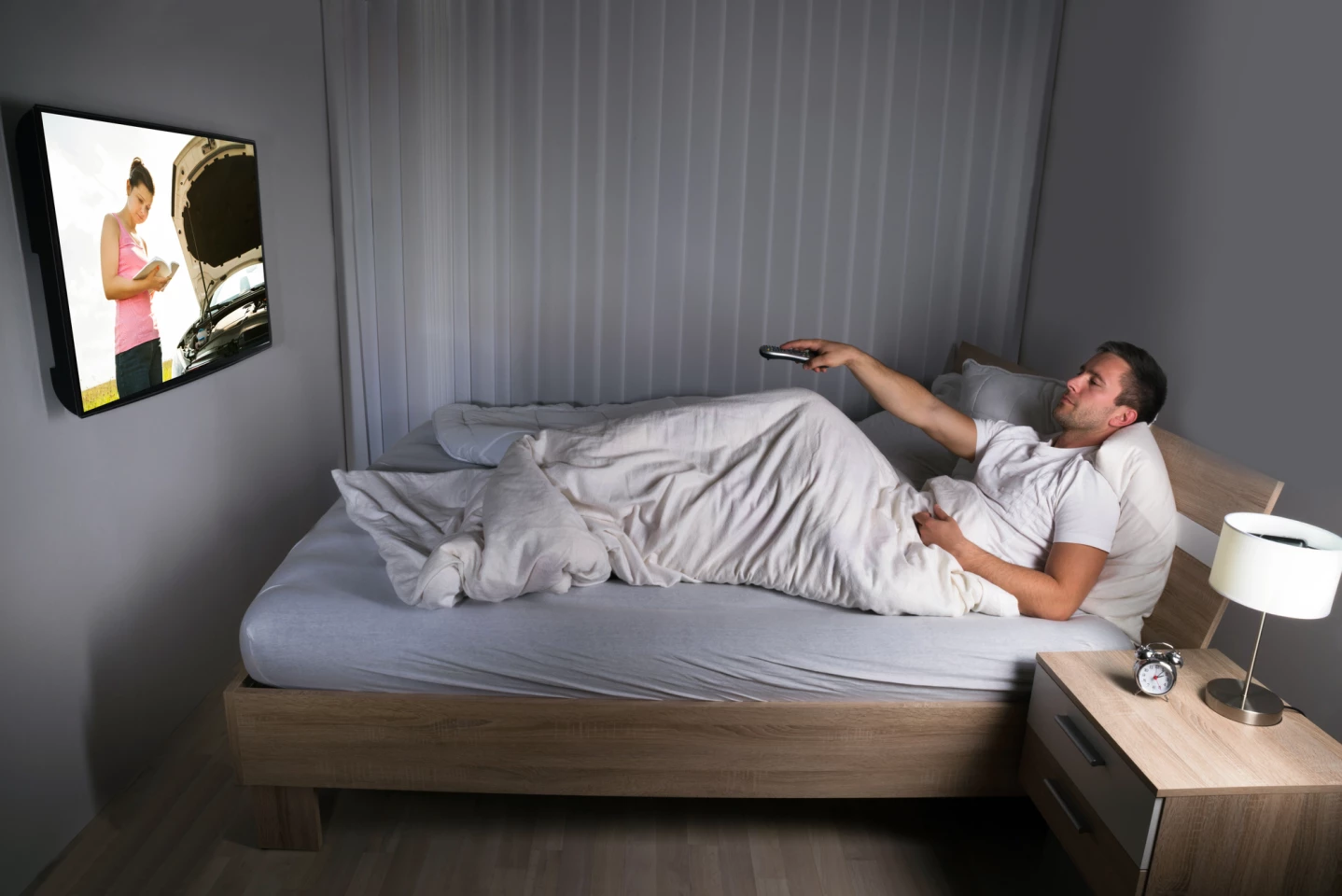Self-care life hacks, claimed to improve well-being, often go viral on social media platforms like TikTok, sometimes without scientific backing. Experts have shared their opinion on six popular behaviors, from bed rotting to sleepmaxxing, so you know what’s actually good.
Life hacks are methods for making daily tasks easier, more efficient, or more enjoyable. These hacks can include simple, actionable strategies for improving mental health and well-being as well. And they're the kinds of things that become viral sensations on the social media platform TikTok.
The problem is that, sometimes, there's a lack of science behind the behaviors. Experts from the University of California, San Diego (UC San Diego) have given their opinion on the validity of six of TikTok’s most popular self-care hacks for improving mental health and well-being, from sipping cortisol “cocktails” to bed rotting.
Cortisol “cocktails”
Cortisol is best known as the hormone that’s released by the body’s adrenal glands in times of stress. Prolonged elevated cortisol levels caused by long-term stress can lead to health issues, including increased risk of heart disease, weight gain, sleep problems, and mood disorders. For a couple of years, social media feeds have been touting the benefits of downing so-called cortisol “cocktails” – a mixture of orange juice, sea salt, coconut water and a magnesium supplement – as a way of lowering levels of the stress hormone.

“While a ‘cortisol cocktail’ has been promoted as an easy solution to battle burnout, the scientific data to support such claims is not as conclusive,” said endocrinologist Jodi Nagelberg, MD, an assistant clinical professor of medicine. “It may taste refreshing, but claiming such a cocktail is a ‘fix’ for the effects of chronic stress on one’s body is an exaggeration at best.”
Nagelberg points out that the effects of most of the drink’s ingredients on cortisol levels haven’t been rigorously scientifically evaluated. Or, if they have, the effect is minor.
“If one does feel improved after taking such an antidote, a placebo effect alone cannot be discounted,” she said. “Typically, there is no need to ‘fix’ one’s cortisol levels, but rather target the underlying cause of chronic stress as a means of improving one’s overall health.”
It’s important to note that a drink like this, which has a high sugar content without the sugar-regulating properties of nutrients like fiber and protein, might be problematic for diabetics. And the drink’s high potassium levels may be harmful for those with kidney failure or chronic kidney disease.
“While many of these hacks may be safe yet ineffective, excessive intake of various vitamins or minerals can cause physical harm,” said Nagelberg.
Brain rot
After a public vote, “brain rot” was named the 2024 Oxford Word of the Year. It’s defined as “the supposed deterioration of a person’s mental or intellectual state, especially viewed as the result of overconsumption of material (now particularly online content) considered to be trivial or unchallenging.” One brain rot behavior you may have heard of is doomscrolling, which involves scrolling through negative or upsetting online news stories over extended periods.
“Although the term ‘brain rot’ may sound like a joke, zoning out to short-form, stimulating content can alter how the brain develops and functions,” said Ekta Patel, MD, Assistant Professor of Psychiatry at UC San Diego’s School of Medicine. “Over time, this can desensitize the brain’s natural reward pathway, making everyday activities such as work, school, reading or face-to-face conversations feel boring or mundane in comparison.”

Patel believes that engaging in brain rot behaviors can be helpful for mental health, but caution should be exercised.
“Turning to light, feel-good content to unwind or disconnect is not inherently harmful; in fact, it can be a low-stakes way to regulate in small doses,” she said. “When this kind of content consumption becomes the primary way to manage distress, it can drift into what we call emotional avoidance or dissociation. The key is intention. Are we using it to gently recharge, or to disconnect completely from our internal world? This question can help answer if it’s a coping tool or a barrier to healing.”
Sleepmaxxing
The term “sleepmaxxing” originated on social media platforms like TikTok and is used to describe techniques and products aimed at improving sleep. It covers everything from piling weighted blankets on your bed to taping your mouth shut to force you to breathe through your nose.
“Experts agree optimal sleep duration is seven to nine hours a night,” said Michael McCarthy, MD, PhD, a Professor of Psychiatry with a research interest in circadian rhythms. “Getting insufficient sleep is linked with poor health, but going beyond nine hours is also associated with bad outcomes, including earlier mortality.”
McCarthy agreed that while some sleepmaxxing techniques have merit – keeping the room cool and dark, managing stress, using white noise if ambient sounds are a problem, for example – others, such as mouth-taping, “have not been well-studied for sleep and may come with unanticipated and unwanted effects on health.” And he emphasized that worrying about getting the best night’s sleep can be counterproductive.
“Anxiety of any kind, including obsessive worrying about sleep, can cause sleep problems,” he said. “Keeping a consistent sleep-wake schedule is helpful and trains the body to know when sleep should come. Spending time outdoors, especially in the early morning, is key to maintaining healthy circadian rhythms.”
Manifesting

Manifesting is the idea that if we believe in something – self-confidence, a romantic relationship, money, a new house, the dream job, better health – we can will it into existence. The concept is not new; it has been around for centuries. But it has found new adherents in recent years, thanks to social media. Admittedly, manifesting does sound a little pseudoscience-y, but with people like Oprah Winfrey, Eckhart Tolle, and Deepak Chopra behind it, it’s easy to see how it went viral. So, what do the experts say?
“Where your mind goes, your energy flows,” said E. Nathaniel Chapman, PsyD, assistant teaching professor in UC San Diego’s Department of Psychology. “Optimism provides the groundwork, but behavioral follow-through is required for lasting success.”
According to Chapman, deciding what it is you want in life is just the first step.
“Entitlement – expecting something for nothing – can be detrimental,” he said. “If you have a clear goal and stay focused, your brain will start creating plans – but you have to act on them. That’s when the rough waters come. Not every plan will work, but if you keep adjusting and trying again, you’ll eventually get to where you’re going.”
Bed rotting
The viral self-care trend “bed rotting” involves staying in bed for a whole day. The point of the behavior is to rest and recharge without feeling pressured by the need to be productive. Instead, you do little more than watch TV, read a book, or scroll through social media. As with pretty much everything, it has its pros and cons.
“Sometimes your body really does need a day of rest, and you shouldn’t shame yourself for that,” said mindfulness expert and Professor of Psychology Karen Dobkins, PhD. “But there are also days your body needs to move. I don’t have a prescription except to say: pay attention. The key is learning to listen.
“If you don’t use your body, then you’re not building a relationship with it. Bodies have important signals for us all day long – not just hunger, but stress, discomfort and more.”
With bed rotting, it seems (again, as is the case with pretty much everything), it boils down to maintaining balance and not doing too much of a ‘good’ thing.
Floor time
“Floor time” is exactly what it sounds like: lying on the floor. The practice has gone viral on TikTok, with its proponents swearing that spending a few minutes lying on a hardwood floor, carpet, or even grass is an easy way to relax and de-stress. And they might be onto something.
“When you lie down, you connect with your body rather than your mind – that’s the first thing that happens,” said Pollyanna Casmar, PhD, a clinical professor in psychiatry who provides care for veterans across the spectrum of mental health disorders. “We’re so caught in our heads all the time that we lose touch with what’s happening in our bodies.”
Casmar said that lying on a firm surface helps to activate the body’s parasympathetic nervous system. Whereas the sympathetic nervous system drives our "fight or flight" response, the parasympathetic nervous system regulates our "rest and digest" response; it’s what calms us. The more we do it, she said, the more the practice should be able to regulate stress and restore bodily balance.
If you can’t stretch out on the floor, Casmar suggests sitting in a chair with your feet on the ground and practicing “vagus breathing.” Breathing in and sighing out slowly for longer than your in breath with an open mouth can activate the vagus nerve, a crucial component of the parasympathetic nervous system.
Source: UC San Diego








